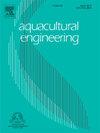Factors influencing feed distribution uniformity in aquaculture vessels based on DEM
IF 3.6
2区 农林科学
Q2 AGRICULTURAL ENGINEERING
引用次数: 0
Abstract
To meet the feeding operation requirements of aquaculture vessels and enhance feed quality while minimizing fish competition and uneven feeding—factors that can degrade feed quality—a low-speed, uniformly distributing feeding disk was designed. This study uses Star-CCM+ to simulate the feed dispersal process of the rotating feeding disk and analyzes the effects of various factors on feed particle distribution. A discrete element model based on the mesh-free method was developed, incorporating the Hertz-Mindlin contact model for discrete feed particles, with rotating speed, height above the water surface, and initial particle velocity as variables. The shape and range of the dispersed feed distribution were observed. The results indicate that appropriately increasing the rotating speed or height improves feed distribution uniformity and increases the dispersal range. The optimal feeding effect is achieved when the drop height is 2 m and the rotating speed is 20 rpm. To evaluate the impact of ship roll on feed distribution, initial particle velocities were set to simulate changes under unstable sea conditions. When the initial particle velocity is 0.75 m/s, increasing the rotating speed to 20 rpm enhances distribution uniformity. This study provides valuable insights into the design and operational parameters of rotating feeding disks and serves as a reference for the development of feeding equipment for aquaculture vessels.
基于DEM的水产养殖船舶饲料均匀性影响因素研究
为了满足养殖船舶的投料作业要求,提高饲料质量,同时最大限度地减少鱼类竞争和投料不均匀等降低饲料质量的因素,设计了低速均匀分布的投料盘。本研究利用Star-CCM+ 模拟了旋转进料盘的进料分散过程,分析了各种因素对进料颗粒分布的影响。建立了基于无网格法的离散元模型,结合离散进料颗粒的Hertz-Mindlin接触模型,以转速、水面高度和颗粒初始速度为变量。观察了分散饲料分布的形状和范围。结果表明,适当提高转速或旋转高度可改善进料分布均匀性,增加分散范围。投料高度为2 m,转速为20 rpm时,投料效果最佳。为了评估船舶横摇对饲料分布的影响,设置初始粒子速度来模拟不稳定海况下的变化。当初始颗粒速度为0.75 m/s时,将转速提高到20 rpm可以提高颗粒分布的均匀性。本研究为旋转投喂盘的设计和操作参数提供了有价值的见解,为水产养殖船舶投喂设备的开发提供了参考。
本文章由计算机程序翻译,如有差异,请以英文原文为准。
求助全文
约1分钟内获得全文
求助全文
来源期刊

Aquacultural Engineering
农林科学-农业工程
CiteScore
8.60
自引率
10.00%
发文量
63
审稿时长
>24 weeks
期刊介绍:
Aquacultural Engineering is concerned with the design and development of effective aquacultural systems for marine and freshwater facilities. The journal aims to apply the knowledge gained from basic research which potentially can be translated into commercial operations.
Problems of scale-up and application of research data involve many parameters, both physical and biological, making it difficult to anticipate the interaction between the unit processes and the cultured animals. Aquacultural Engineering aims to develop this bioengineering interface for aquaculture and welcomes contributions in the following areas:
– Engineering and design of aquaculture facilities
– Engineering-based research studies
– Construction experience and techniques
– In-service experience, commissioning, operation
– Materials selection and their uses
– Quantification of biological data and constraints
 求助内容:
求助内容: 应助结果提醒方式:
应助结果提醒方式:


